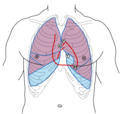Cardiovascular examination
Cardiovascular Examination is a critical component of the physical examination conducted by healthcare professionals to assess the cardiovascular system. It involves a systematic evaluation of the heart and blood vessels, and it is essential in diagnosing various cardiovascular diseases.
Overview[edit]
The cardiovascular examination is a comprehensive assessment that includes the evaluation of the patient's medical history, a physical examination, and often, further diagnostic tests. The examination is typically performed in a systematic manner, starting with inspection, followed by palpation, percussion, and auscultation.
Inspection[edit]
Inspection involves observing the patient for any visible signs of cardiovascular disease. This may include noting the patient's color, breathing pattern, and any visible pulsations. The healthcare professional may also look for signs of peripheral vascular disease such as varicose veins or ulcers.
Palpation[edit]
Palpation involves the use of the hands to feel the chest wall for any abnormal vibrations or movements. The healthcare professional may also palpate the peripheral pulses to assess their strength and rhythm.
Percussion[edit]
Percussion is less commonly used in the cardiovascular examination but can be helpful in assessing the size and borders of the heart.
Auscultation[edit]
Auscultation involves listening to the heart sounds with a stethoscope. The healthcare professional listens for the normal heart sounds, as well as any additional sounds such as murmurs or rubs that may indicate disease.
Diagnostic Tests[edit]
Further diagnostic tests may be performed based on the findings of the cardiovascular examination. These may include electrocardiogram (ECG), echocardiogram, and cardiac stress test.
Conclusion[edit]
The cardiovascular examination is a vital tool in the diagnosis and management of cardiovascular diseases. It requires a thorough understanding of the cardiovascular system and the ability to interpret the findings accurately.

This article is a cardiovascular system stub. You can help WikiMD by expanding it!
-
Location of Heart Sounds for Auscultation
Ad. Transform your life with W8MD's Budget GLP-1 injections from $75


W8MD offers a medical weight loss program to lose weight in Philadelphia. Our physician-supervised medical weight loss provides:
- Weight loss injections in NYC (generic and brand names):
- Zepbound / Mounjaro, Wegovy / Ozempic, Saxenda
- Most insurances accepted or discounted self-pay rates. We will obtain insurance prior authorizations if needed.
- Generic GLP1 weight loss injections from $75 for the starting dose.
- Also offer prescription weight loss medications including Phentermine, Qsymia, Diethylpropion, Contrave etc.
NYC weight loss doctor appointmentsNYC weight loss doctor appointments
Start your NYC weight loss journey today at our NYC medical weight loss and Philadelphia medical weight loss clinics.
- Call 718-946-5500 to lose weight in NYC or for medical weight loss in Philadelphia 215-676-2334.
- Tags:NYC medical weight loss, Philadelphia lose weight Zepbound NYC, Budget GLP1 weight loss injections, Wegovy Philadelphia, Wegovy NYC, Philadelphia medical weight loss, Brookly weight loss and Wegovy NYC
|
WikiMD's Wellness Encyclopedia |
| Let Food Be Thy Medicine Medicine Thy Food - Hippocrates |
Medical Disclaimer: WikiMD is not a substitute for professional medical advice. The information on WikiMD is provided as an information resource only, may be incorrect, outdated or misleading, and is not to be used or relied on for any diagnostic or treatment purposes. Please consult your health care provider before making any healthcare decisions or for guidance about a specific medical condition. WikiMD expressly disclaims responsibility, and shall have no liability, for any damages, loss, injury, or liability whatsoever suffered as a result of your reliance on the information contained in this site. By visiting this site you agree to the foregoing terms and conditions, which may from time to time be changed or supplemented by WikiMD. If you do not agree to the foregoing terms and conditions, you should not enter or use this site. See full disclaimer.
Credits:Most images are courtesy of Wikimedia commons, and templates, categories Wikipedia, licensed under CC BY SA or similar.
Translate this page: - East Asian
中文,
日本,
한국어,
South Asian
हिन्दी,
தமிழ்,
తెలుగు,
Urdu,
ಕನ್ನಡ,
Southeast Asian
Indonesian,
Vietnamese,
Thai,
မြန်မာဘာသာ,
বাংলা
European
español,
Deutsch,
français,
Greek,
português do Brasil,
polski,
română,
русский,
Nederlands,
norsk,
svenska,
suomi,
Italian
Middle Eastern & African
عربى,
Turkish,
Persian,
Hebrew,
Afrikaans,
isiZulu,
Kiswahili,
Other
Bulgarian,
Hungarian,
Czech,
Swedish,
മലയാളം,
मराठी,
ਪੰਜਾਬੀ,
ગુજરાતી,
Portuguese,
Ukrainian
